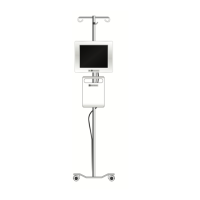Physiology and Physio Relationship Monitoring Screens
8-3
The Historic Physio Relationship screen allows the user to
enter parameters used to calculate derived parameters DO
2
and VO
2
e, on only the most recent record. The values
entered are for the time of the record and not the current
time.
The Historic Physio Relationship screen is accessed
through the clock/waveform icon on the continuous Physio
Relationship Screen. Touch the Return button to return to
the continuous Physio Relationship Screen. There is no 2
minute time-out for this screen.
Parameter Boxes
Each small parameter box displays:
• Parameter name
• Parameter units
• Parameter value (if available)
• Clinical target Indicator (if a value is available)
• For SVV, the two SVV indicators are displayed when
applicable.
If the parameter is in a fault state, the value is blank,
indicating it is or was unavailable at the time of the display.
Physio Relationship Alarms/Targets and
Historical Data Screens
Touch a parameter to bring up the Alarm/Target popup to
change the target settings. See Chapter 6: Alarms / Targets on
page 6-5.
Touching HGB, SpO
2
or ScvO
2
brings up a small popup
allowing the user to change the target settings or enter a value.
When the value is accepted, a new record is created. It
includes:
• Current continuous parameter data.
• The entered value and any derived calculated values.
The historic physio relationship screen is shown with the
newly created record; the remaining manually entered values
can then be entered to calculate the derived values.
Figure 8-6 Physio Relationship Parameter
Boxes
Parameter/ Value Clinical SVV Filtering Faulted or
and Units Indicator Exceeded value not
Indicator available
Figure 8-7 Physio Relationship Target Popup
WARNING
Physiological visual and audible physiological alarms
are activated only if the parameter is selected and
displayed on the screens as a key parameter (1-4
parameters). If a parameter is not selected and
displayed as a key parameter, the audible physiological
alarms are silenced.

